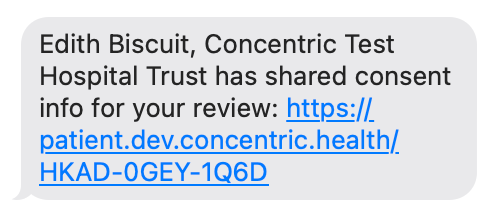Sharing information with patients
A key benefit of Concentric is that information is easily shared with patients to support decision making, as a record, and to support during recovery.
Benefits of sharing information digitally
Prior to using digital consent, organisations that now use Concentric were repeatedly seeing that consent documentation and generic patient information leaflets was rarely being shared with patients (and when it was it would often be in the form of an illegible carbon copy of the consent form). Concentric makes it easy to share personalised, evidence-based information through an intuitive user interface.
The vast majority of patients do access their information digitally, regardless of their age, and many return to the information a number of times. A key theme in patient feedback is that having all their information in one place, with links to further resources is really appreciated, both before and after treatment.
Options for sharing information
Information can be shared via Concentric by either or both of email and text message. Where there are integrations with the organisation’s electronic health record these will be prepopulated when available (our experience so far is that most patients have an email as part of the record, and almost all have a mobile number recorded).
Templates used to share information
There are a number of different templates used to share information with patients, depending on the context and whether an email or text message is being sent (we try to keep the copy shorter for text messages but what is covered remains the same).
These screenshots give an idea of what the email and text message look like:
Email:

Text message:

Where remote consent has been enabled, or the signed consent form is also available, this is flagged to the patient.
When sharing with patients, there is also the option to add an additional note into the message.
Secure patient access
Patients are sent a unique link which, after confirming their date of birth, gives them access to their consent episode. This form of second factor authentication, alongside the number of possible URL combinations (in excess of 1018), means that only the patient has access to the information.
Will the patient be told my email address or mobile number? No, the patient communications come directly from Concentric. The name of the clinician sharing the information is shown, but neither their email address or phone number is visible to the patient as part of this communication.